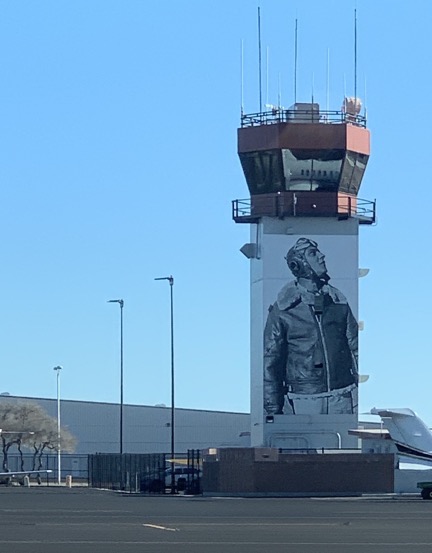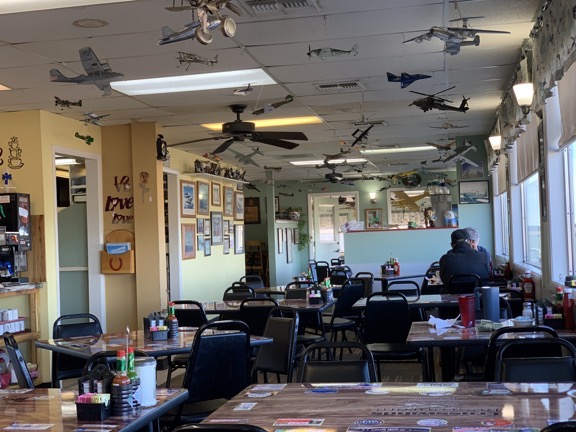I get to ride in the back seat of a small plane behind two generations of pilots.
I spent the last day in January at Falcon Field airport in Mesa, AZ, hanging around with some friends who own a flight school. A highlight of the day was a trip up to Payson, AZ in a Cessna 182 for lunch with my friend Woody and his newly minted private pilot daughter Lindsay.
I’m not a big fan of small airplanes, partly because you can feel turbulence so much more in a plane than a helicopter and partly because I’d spent more time than I wanted to as a passenger in my wasband’s Grumman Tiger with him at the controls. He was a nervous pilot who constantly chased the RPM with the throttle in flight and didn’t let me talk if the air wasn’t perfectly calm. I often got the impression that he was overwhelmed with the task and, because of that, I was never really confident of his skills. Since I don’t fly airplanes, takeoffs (with a stall horn blaring) and landings (which were seldom on the runway centerline) terrified me. I may have screamed once on a particularly bad landing in Wickenburg.

Back at Falcon Field, I managed to get a halfway decent shot of the artwork painted on the Falcon Field tower, which is visible from the runway.
Fortunately, I have a lot of pilot friends with a lot more experience and, therefore, skills and confidence. Woody is one of these friends. A retired airline pilot who loves to fly, Woody has flown a wide range of aircraft, from tiny Pipers and Cessnas to Boeing and Airbus airliners to Robinson and Schweizer helicopters. If you follow my FlyingMAir channel on YouTube, you may have seen him showing off the King Air he flew up to Washington with his dog and another pilot to spend a week with me. In the past 8 years or so, I’ve flown with plenty of experienced airplane pilots like Woody and I find it an enjoyable, worry-free experience — as long as the turbulence isn’t too bad.
So when Woody invited me to join him and his daughter for a flight up to Payson for lunch, I was all in. They were flying our friend Jan’s Cessna 182, which was a complex airplane. Lindsay had just gotten her private pilot certificate and was on a training path to become an airline pilot. She needed to build experience and get endorsements for a variety of airplane types and the complex Cessna was the first challenge. She sat on the left (the pilot seat in most planes) and Woody sat on the right. I sat in back, which was surprisingly roomy.

Jan’s Cessna 182.
The flight was uneventful, although there was just enough turbulence to remind me that I was in a small plane. Woody let Lindsay do all the flying, providing firm instruction when needed but never touching the controls. Lindsay was focused and trying hard to do everything perfectly, but she had the air of someone who was knowledgeable and confident. Our landing in Payson was a bit bumpy, but she greased it back in Mesa. I didn’t hear a stall horn once. Along the way, I was reminded about how poor the visibility is our the front of an airplane with that big fat engine and propeller blocking the view.

Lindsay and Woody, side by side on takeoff at Falcon Field. I think Woody was really proud of her — and he should be!

I took pictures and shot video all the way up to Payson and back. I’m not sure, but I think this might be Bartlett Lake along the Verde River.
We parked and got out at Payson, which, because of its higher elevation, was a lot cooler than the Phoenix area. We went into the nearly deserted airport restaurant and had lunch. My patty melt was delicious and huge; I took half in a to-go box. We wanted to buy t-shirts, but they only had size Small left.

The restaurant at the airport was nearly empty when we arrived.
We headed back to Mesa right after lunch — there wasn’t anything else to do at the airport. I got a chance to admire Lindsay’s radio skills. I was a little envious. She was so young, with her whole life ahead of her and a dad to help guide her into an interesting and rewarding career. I complemented her on her flying skills and wished her the best of luck with her training and future.
Discover more from An Eclectic Mind
Subscribe to get the latest posts sent to your email.

Yes, wish Lindsay good luck….
I have spent many happy hours (and a few stressful ones) in those Cessnas, from the tiny C152 to the one you were in, including its equivalent with floats.
You mention the stall-warner. On a calm day it’s quite nice to get a short alert from the stall-warner if you are a foot or less from touch-down. It means the landing is likely going to be a ‘greaser’. But the stall-warner sounding on take off or climb out is quite another story.
Yikes!
I agree about the stall horn on landing. I actually like that little beep just before you touch down. It means you’re going as slow as you can. Nice. But on takeoff when the inexperienced pilot can’t stay centered over the runway and can’t seem to get the right airspeed/aircraft pitch combination to keep the horn quiet? Well, for me that’s terrifying.
Remember, helicopter pilots don’t need airspeed to stay aloft.